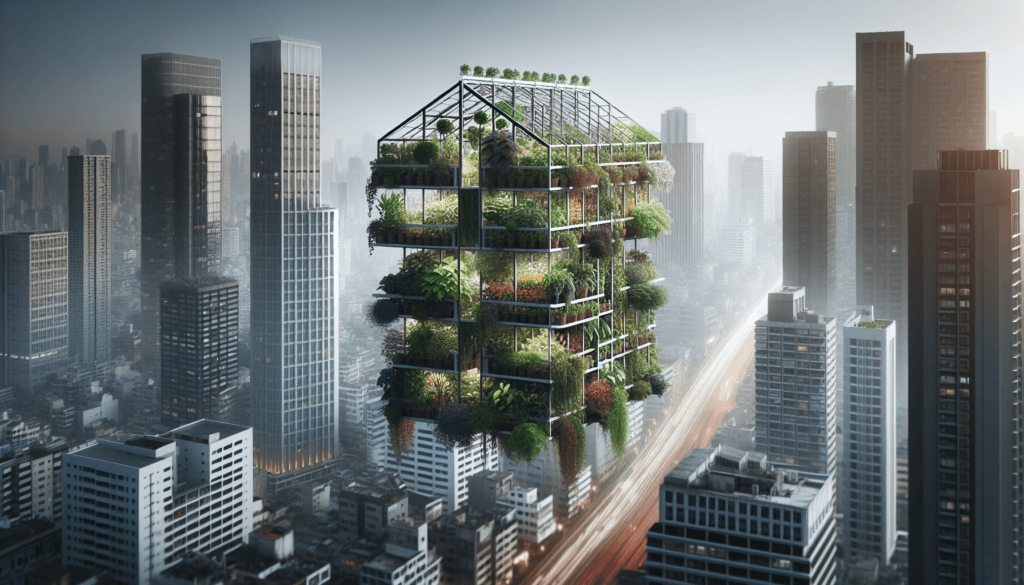Imagine transforming your cramped urban space into a lush oasis of greenery with these simple DIY vertical gardening ideas. Whether you have a small balcony, a minuscule courtyard, or just a plain wall, these innovative ideas will help you maximize your space and create a stunning vertical garden. From hanging plants to cascading vines, discover how to bring nature’s beauty into your urban space in a practical and cost-effective way. Get ready to embark on a green adventure as we explore the world of DIY vertical gardening and unlock the potential of your urban space.

Container Gardening
Container gardening is a popular and practical way to grow plants in urban spaces. Whether you have a small balcony, patio, or even just a sunny windowsill, you can create a beautiful garden with the right containers. Choosing the right containers is crucial for the success of your vertical garden. Consider the size, material, and drainage capabilities of the containers. Opt for containers that are large enough to accommodate the root systems of your plants, but not so large that they become difficult to manage. Plastic, ceramic, and wooden containers are all excellent options. Ensure that your containers have proper drainage holes to prevent waterlogging and root rot.
Vertical Container Gardening Ideas
If you have limited horizontal space, why not go vertical with your gardening? Vertical container gardening is a space-saving and creative solution that allows you to maximize your growing area. There are several ideas to consider when it comes to vertical container gardening. One option is to use hanging baskets. These can be hung from hooks or brackets on walls or fences, adding a beautiful touch of greenery to your outdoor space. Another idea is to utilize vertical pallet gardens. By repurposing old wooden pallets, you can create a unique and functional vertical garden. Simply attach the pallet to a wall or fence and fill the gaps with soil and plants. Tower gardens are another fantastic choice for vertical container gardening. These freestanding structures feature multiple tiers or pockets, allowing you to grow a variety of plants in a small footprint.
Hanging Baskets
Hanging baskets are a classic and versatile option for vertical gardening. They are easily adjustable and can be hung at various heights, depending on your space and plant preferences. Hanging baskets come in a variety of materials and designs, allowing you to choose the perfect style for your garden. Whether you prefer traditional woven baskets, modern metal or plastic baskets, or even decorative ceramic options, there is a hanging basket out there to suit your taste. Fill your hanging baskets with a mix of trailing plants, such as ivy, petunias, or trailing begonias, for a stunning cascade of color and foliage. Hang them from walls, fences, pergolas, or even shepherd’s hooks for a delightful display.
Vertical Pallet Gardens
Vertical pallet gardens are an excellent way to add a touch of rustic charm to your vertical gardening efforts. By repurposing old wooden pallets, you can create a vertical garden that is both functional and aesthetically pleasing. To create a vertical pallet garden, start by attaching the pallet to a wall or fence. Secure it firmly to ensure stability. Then, fill the gaps between the slats with soil and plants. You can choose a variety of plants, from herbs and flowers to small vegetables or succulents. The vertical orientation of the pallet allows for excellent drainage and creates an eye-catching display. Consider adding small hanging baskets or pockets to the pallet for additional growing space.

Tower Gardens
Tower gardens are a fantastic option for vertical container gardening. These freestanding structures feature multiple tiers or pockets, allowing you to grow a wide range of plants in a small footprint. Tower gardens are available in various sizes, from compact designs suitable for balconies to larger options for spacious patios or gardens. They can be made from metal, plastic, or even wood, depending on your preference and budget. To set up a tower garden, simply stack the tiers or attach the pockets, fill them with soil, and plant your desired herbs, flowers, or vegetables. Tower gardens are not only practical and space-saving but also create an impressive vertical focal point in your garden.
Wall-Mounted Gardens
If you want to save space and add a unique touch to your vertical gardening, consider wall-mounted gardens. There are several options available, ranging from living wall systems to vertical wall planters and even gutter gardens.
Living Wall Systems
Living wall systems are a striking way to bring nature to your walls. These systems usually consist of a grid or panels that can be mounted to a wall and filled with plants. The plants are typically inserted into pockets or mounted in small containers on the grid. Living wall systems are versatile and can be installed both indoors and outdoors, adding a touch of green to any space. They are ideal for growing a variety of plants, including herbs, succulents, and even flowers. With proper irrigation and care, living walls can flourish and create a stunning visual display.
Vertical Wall Planters
Vertical wall planters are another excellent option for wall-mounted gardens. These planters are designed to be hung directly on walls, allowing you to utilize vertical space effectively. Vertical wall planters come in various materials, including plastic, metal, and even fabric. They typically feature multiple pockets or slots where you can plant your desired plants. The planters can be arranged in different patterns or configurations to create a unique and visually appealing display. Vertical wall planters are particularly well-suited for herbs, small flowers, and succulents.
Gutter Gardens
Gutter gardens are an innovative and cost-effective way to transform an old rain gutter into a vertical garden. This DIY project involves mounting a section of rain gutter horizontally on a wall or fence and attaching end caps to prevent soil from falling out. The gutter can then be filled with soil and plants. Gutter gardens are ideal for growing shallow-rooted plants such as herbs or lettuce. They can be easily mounted in small spaces and can even be arranged in a cascading or stair-step pattern for added visual interest.
Shoe Organizers
Repurposing a shoe organizer is an ingenious way to create a wall-mounted vertical garden. These organizers, typically made of fabric or plastic, feature numerous pockets that can be filled with soil and plants. Hang the shoe organizer on a wall or fence, ensuring it is securely attached. Fill each pocket with your desired plants, making sure to choose appropriate varieties for the size of the pockets. Shoe organizer gardens are perfect for growing small herbs, flowers, or even succulents. They are easy to install, budget-friendly, and allow you to make the most of your vertical space.

Hanging Gardens
Hanging gardens are a beautiful and space-saving option for vertical gardening. Whether you have a sunny window or a balcony railing, you can create a stunning hanging garden with a little creativity and the right materials.
Macrame Plant Hangers
Macrame plant hangers are a trendy and stylish way to showcase your plants. These hanging plant holders are made from knotted cords and can be suspended from hooks or brackets. Macrame plant hangers come in various intricate designs and lengths, allowing you to choose the perfect one for your plants and space. They add a touch of bohemian charm to any room or outdoor area. Fill them with pothos, spider plants, or other trailing species for a cascading effect.
Repurposed Materials
When it comes to hanging gardens, don’t be afraid to get creative with repurposed materials. Look around your home or local thrift stores for items that can be transformed into unique hanging planters. Old teapots, colanders, or even mason jars can be repurposed as hanging planters with a little ingenuity. Simply attach hooks or chains to these items and fill them with your favorite plants. Repurposed materials add character and charm to your vertical garden, making it truly one-of-a-kind.
DIY Hanging Planter Ideas
If you enjoy DIY projects, consider making your own hanging planters. There are countless ideas and tutorials available online that cater to various skill levels. From macrame plant hangers to hanging baskets made from recycled materials, the possibilities are endless. Get creative with different materials, colors, and sizes to design a hanging planter that reflects your style and personality. DIY hanging planters are not only cost-effective but also allow you to customize your vertical garden to your exact preferences.
Vertical Herb Gardens
Growing herbs vertically is a practical and rewarding way to have a fresh supply of culinary delights right at your fingertips. Whether you have a small kitchen or a balcony with limited space, there are several vertical herb gardening options to consider.
Indoor Herb Gardens
Indoor herb gardens are perfect for those who have limited outdoor space or want to enjoy fresh herbs all year round. There are various indoor herb garden kits available that make the process simple and enjoyable. These kits usually include everything you need to get started, including small pots or containers, soil, and herb seeds or seedlings. Choose a sunny spot in your home, such as a windowsill or countertop, and set up your indoor herb garden. Remember to water your herbs regularly and provide them with adequate sunlight or artificial lighting for optimal growth.
DIY Herb Spiral
A DIY herb spiral is a visually captivating and space-efficient way to grow a wide range of herbs. The spiral design allows for varying microclimates, with herbs that prefer different growing conditions positioned at different levels. To create a herb spiral, mark out the desired size and shape on the ground or in a raised bed. Begin building your spiral by stacking rocks, bricks, or other suitable materials in a spiral pattern, gradually moving upwards. Fill each level with soil, making sure to amend it with compost or organic matter. Plant your herbs according to their individual preferences, with those that prefer drier conditions higher up and those that prefer more moisture at the bottom. Herb spirals are not only practical but also add a unique focal point to your garden.
Vertical Herb Wall
A vertical herb wall is a stunning and space-saving way to grow an abundance of herbs. Whether you choose to purchase a pre-made vertical herb wall system or build your own, this vertical gardening technique is sure to impress. Vertical herb walls typically consist of multiple pockets or containers that can be attached to a wall or fence. Fill each pocket with soil and plant your desired herbs. Make sure to choose a mix of herbs with similar growing requirements to ensure their success. Vertical herb walls are ideal for small spaces and allow you to conveniently harvest fresh herbs whenever you need them.
Herb Ladder Planter
A herb ladder planter is a charming and functional addition to any outdoor space. This DIY project involves building a ladder-shaped structure with multiple tiers or shelves to hold pots or containers. The ladder can be made from wood or metal, depending on your preference and skill level. Attach the pots or containers to each tier and fill them with soil. Plant your herbs, ensuring that each pot has adequate drainage. Herb ladder planters are versatile and can be placed on a patio, balcony, or in a garden. They add vertical interest and provide a convenient way to grow and harvest a variety of herbs.

Vertical Vegetable Gardens
Growing vegetables vertically is an excellent way to maximize your garden space and increase your overall yield. Whether you have a small backyard or a balcony, there are several options for vertical vegetable gardening that allow you to grow a wide range of delicious vegetables.
Container Vegetable Gardens
Container vegetable gardens are a popular choice for vertical vegetable gardening. With the right containers and soil, you can grow a variety of vegetables in a small space. Choose containers that are large enough to accommodate the root systems of your vegetables, but not so large that they become difficult to manage. Opt for deep containers to allow for adequate soil depth. Fill the containers with well-draining soil and plant your desired vegetables. Tomatoes, peppers, lettuce, and herbs are all excellent choices for container vegetable gardens. Remember to provide your vegetables with adequate sunlight, water, and nutrients for optimal growth.
Vertical Trellis Systems
Vertical trellis systems are a practical and efficient way to grow vining vegetables such as beans, cucumbers, and peas. These systems typically consist of sturdy frames or structures with support wires or strings. The vining vegetables are trained to grow vertically, allowing them to take up less space and receive better airflow and sunlight. Install your trellis system in a sunny area of your garden or on a balcony. Plant your vining vegetables at the base of the trellis and guide their growth upwards using twine or clips. Vertical trellis systems not only save space but also make harvesting and maintaining your vegetable plants easier.
Self-Watering Vertical Gardens
Self-watering vertical gardens are an excellent option for those who want to simplify their gardening routine. These systems have built-in water reservoirs that provide a consistent water supply to the plants, reducing the need for frequent watering. Self-watering vertical gardens can be purchased as pre-made systems or made as a DIY project. Choose plants that have similar moisture requirements, as they will be sharing the same reservoir. Fill your vertical garden with soil and plant your vegetables, ensuring that each plant’s roots have access to the self-watering system. These gardens are ideal for small spaces and provide a consistent and efficient watering solution.
Vertical Straw Bale Gardens
Vertical straw bale gardens are a unique and eco-friendly way to grow vegetables. Straw bales act as natural containers and provide a nutrient-rich environment for plants. To create a vertical straw bale garden, start by placing the bales in a sunny area of your garden or on a patio. Position them vertically, with the cut side facing up. Condition the bales by watering them thoroughly for several days before planting. Once the bales have conditioned, create small pockets in the straw and fill them with soil and seedlings. Ensure that the seedlings have adequate contact with the soil and water regularly. Vertical straw bale gardens are a low-maintenance option and can be easily composted or used as mulch once the growing season is over.
Creative DIY Structures
If you’re feeling adventurous and want to dive into more complex DIY projects, there are several creative structures you can build to enhance your vertical gardening experience.
Vertical Garden Towers
Vertical garden towers are an impressive way to create a vertical garden oasis. These structures typically consist of stacked pots or containers, with each tier accommodating a different plant. You can create your own vertical garden tower by stacking terra cotta pots or plastic containers, securing them with a sturdy support rod in the center. Fill each pot or container with soil and plant your desired flowers, herbs, or vegetables. As the plants grow, they will create a lush and vibrant tower of greenery. Vertical garden towers are not only visually appealing but also provide excellent drainage and airflow for healthy plant growth.
PVC Pipe Gardens
PVC pipe gardens are an innovative and cost-effective way to create a vertical garden. These DIY structures utilize PVC pipes to create vertical growing spaces for your plants. Start by cutting PVC pipes into sections of your desired length. Attach multiple sections together using PVC connectors or adhesive. Drill holes into the pipes at regular intervals to allow for plant insertion. Fill the pipes with soil and plant your desired herbs, flowers, or vegetables. PVC pipe gardens can be mounted to walls or fences or secured to stakes in the ground. They are an excellent option for those with limited space or who want to create a unique vertical garden focal point.
Old Ladder Gardens
Repurposing an old ladder into a vertical garden is an excellent way to add character and charm to your outdoor space. Start by cleaning and sanding the ladder to remove any dirt or rough spots. If necessary, paint or varnish the ladder to protect it from the elements. Position the ladder vertically against a wall or fence and secure it with brackets or by burying the bottom legs into the ground. Attach pots or containers to each step or rung of the ladder and fill them with soil and plants. Choose plants that have similar sunlight and watering requirements for optimal growth. Old ladder gardens are a unique and eye-catching addition to any garden or patio.
Shipping Pallet Gardens
Shipping pallet gardens are a popular choice for vertical gardening enthusiasts. With a little creativity and some basic DIY skills, you can transform an old wooden pallet into a functional and attractive vertical garden. Start by cleaning and sanding the pallet to remove any dirt or splinters. You can paint or stain the pallet if desired. Attach a durable landscaping fabric or geotextile to the back and sides of the pallet, ensuring that it extends beyond the edges. This will prevent soil from spilling out while allowing for proper drainage. Once the fabric is secured, fill the gaps between the slats with soil and plant your desired herbs, flowers, or vegetables. Lean the pallet against a wall or fence, ensuring it is stable and secure. Shipping pallet gardens not only save space but also add a rustic and artistic touch to your garden.
Tiered Plant Stands
Tiered plant stands are a versatile and practical option for vertical gardening. These structures typically consist of multiple shelves or tiers, allowing you to display a variety of plants in a compact space. You can purchase pre-made tiered plant stands or build your own using materials such as wood or metal. Ensure that the structure is sturdy and can hold the weight of the plants and soil. Arrange your plants on each tier, with taller plants at the back and shorter plants at the front for optimal visibility. Tiered plant stands are perfect for displaying herbs, succulents, or even small potted flowers. They can be easily moved and placed indoors or outdoors, depending on the season or your preference.

Hydroponic Vertical Gardens
Hydroponic vertical gardens are a modern and efficient way to grow plants without soil. These systems utilize nutrient-rich water to feed the plants, allowing for faster growth and higher yields.
Hydroponic Wall Systems
Hydroponic wall systems are an innovative and space-saving option for vertical gardening. These systems typically consist of a vertical structure with multiple pockets or channels where plants are grown. Nutrient-rich water is circulated through the system, providing the plants with the necessary nutrients. Hydroponic wall systems can be customized to fit your space and plant preferences. They can be installed both indoors and outdoors and are suitable for growing a variety of herbs, lettuce, and even flowering plants. These systems require careful monitoring and maintenance to ensure proper water and nutrient levels.
Vertical NFT Systems
Nutrient Film Technique (NFT) systems are a popular type of hydroponic vertical gardening. In these systems, a thin film of water containing nutrients flows continuously over the roots of plants, providing them with the necessary nutrients. NFT systems are typically built using PVC pipes or troughs. The pipes or troughs are positioned at a slight angle to allow the nutrient solution to flow, while the plants are placed in small pots or net cups with their roots hanging in the film of nutrient-rich water. NFT systems are suitable for growing a wide range of leafy greens, lettuce, and herbs.
DIY Vertical Drip Systems
Vertical drip systems are a simple and effective way to create a vertical garden using a drip irrigation system. These systems typically consist of a series of pipes or tubes that are positioned vertically. At regular intervals, small drip emitters release water and nutrients directly onto the roots of the plants. DIY vertical drip systems can be made using PVC pipes or other suitable materials. Simply drill small holes into the pipes, ensuring that the emitters are positioned above the plant pots or containers. Connect the pipes to a water source and set up a timer to control the watering schedule. Vertical drip systems are versatile and can be customized to fit your space and plant requirements.
Greenhouse Vertical Gardens
Greenhouse vertical gardens are an excellent way to create a controlled environment for your plants. Whether you have a small greenhouse or a dedicated space for indoor gardening, there are several options to consider.
Vertical Espalier Greenhouse
Espalier is a horticultural technique of training trees or shrubs to grow flat against a wall or trellis. In a greenhouse setting, vertical espalier allows you to maximize space and create a lush and productive garden. Start by selecting plants that are suitable for espalier, such as fruit trees or flowering shrubs. Plant these trees or shrubs in pots or containers along a wall or trellis. Use wires or supports to train the plants horizontally and guide their growth vertically. Regular pruning and maintenance are required to keep the plants in shape and ensure proper growth. Vertical espalier greenhouses are not only practical but also create a beautiful and productive display.
Hanging Greenhouse Racks
Hanging greenhouse racks are a convenient way to create a vertical garden in a greenhouse setting. These racks typically consist of metal or wooden frames with multiple shelves where pots or containers can be hung. Hang the racks at suitable heights, ensuring that the plants receive adequate sunlight and airflow. Fill the pots or containers with soil and plant your desired flowers, herbs, or vegetables. Hanging greenhouse racks provide excellent drainage and allow for easy access to your plants. They are particularly well-suited for small spaces and are a great solution for maximizing vertical growing area.
Repurposed Vertical Gardens
Repurposing materials to create a vertical garden is not only environmentally friendly but also allows you to add a unique touch to your urban space. There are several options for repurposed vertical gardens that can be both functional and visually appealing.
Garden on a Pallet
Using a pallet as the foundation for a vertical garden is a popular choice for repurposed gardening. Simply attach small pots or containers to the pallet, ensuring they are securely fastened. Fill the pots or containers with soil and plant your desired herbs, flowers, or vegetables. Lean the pallet against a wall or fence, ensuring stability. Garden on a pallet not only utilizes limited space but also creates a unique and artistic display. It’s a great way to breathe new life into old pallets and create a conversation piece in your urban garden.
Vertical Soda Bottle Garden
Soda bottle gardens are a simple and cost-effective solution for vertical gardening. By repurposing empty soda bottles, you can create a vertical garden that is both practical and visually appealing. Start by cutting the bottom off each bottle and drilling small holes in the cap for drainage. Attach the bottles vertically to a wall or fence, ensuring that they are securely fastened. Fill each bottle with soil and plant your desired herbs, flowers, or vegetables. The transparent bottles allow for easy monitoring of soil moisture and root growth. Vertical soda bottle gardens are perfect for small spaces and can be arranged in various patterns or configurations.
Vertical Gutter Gardens
Repurposing old gutters as vertical gardens is an excellent choice for those with limited space or wanting to recycle materials. Simply mount sections of gutter to a wall or fence, ensuring they are secure. Drill small drainage holes in the bottom of each section. Fill the gutters with soil and plant your desired herbs, flowers, or vegetables. Gutter gardens are particularly suited for shallow-rooted plants such as lettuces, strawberries, or small herbs. They provide excellent drainage and can be easily accessed for watering or harvesting. Vertical gutter gardens are a versatile and practical option for urban gardeners.
Vertical Flower Gardens
Vertical flower gardens are a beautiful and vibrant addition to any urban space. Whether you have a small patio or a balcony, there are several options for creating a stunning vertical flower garden.
Vertical Flower Towers
Vertical flower towers are a visually captivating way to showcase your favorite blooms. These structures typically consist of stacked pots or containers, with each tier accommodating a different flower. You can create your own vertical flower tower by stacking pots or containers of varying sizes, securing them with a sturdy support rod in the center. Fill each pot or container with soil and plant your desired flowers. As the flowers grow, they will create a stunning tower of color and fragrance. Vertical flower towers make for an impressive focal point in any garden or outdoor space.
Wall-Mounted Flower Pockets
Wall-mounted flower pockets are a creative and space-saving option for vertical flower gardens. These pockets are typically made from fabric or felt and can be mounted directly onto walls or fences. Fill each pocket with soil and plant your desired flowers. Wall-mounted flower pockets can be arranged in various patterns or configurations to create a unique and eye-catching display. They are perfect for small spaces or areas that are lacking in soil, such as balconies or patios. Wall-mounted flower pockets add a splash of color and nature to any vertical surface.
Recycled Vertical Flower Beds
Recycled vertical flower beds are an excellent choice for those who want to repurpose materials and create a sustainable vertical garden. You can use a variety of recycled materials, such as old wooden pallets, crates, or even tires, to build unique and functional flower beds. Position the recycled materials vertically, ensuring that they are stable and secure. Fill each bed with soil and plant your desired flowers. Recycled vertical flower beds come in various shapes and sizes, allowing you to get creative with your design. They add a touch of whimsy and uniqueness to any garden or outdoor space.
In conclusion, vertical gardening is an excellent way to make the most of limited space and bring nature into your urban environment. Whether you choose containers, wall-mounted systems, hanging gardens, or DIY structures, there are countless options to suit your style, space, and plant preferences. Get creative, repurpose materials, and enjoy the benefits of a vertical garden that provides beauty, functionality, and a touch of greenery to your urban oasis. Happy gardening!

